Читать книгу Anti-Aging Therapeutics Volume XVI - A4M American Academy - Страница 34
На сайте Литреса книга снята с продажи.
METHOD
ОглавлениеSubjects
All female patients, who presented to a private clinic, at or approaching the typical age of menopause onset were examined. A total of 74 women were entered into the study, although every woman did not have all variables available for analysis. The mean age of the sample was 60.23 (SD = 9.21, range = 43-87]. Medical history, physical examination and laboratory analysis determined that 37 patients had uncomplicated age-related menopause, 11 had menopause related to gynecological surgery, 4 had gynecological organ disease without surgery, and 22 had menopause of ambiguous origin. Each patient filled out an approved IRB PATH informed consent and the IRB committee approved the study on May 20, 2009 [Registration # IRB00002334, Protocol #: LEXMEN001].
Design
All subjects underwent a thorough medical evaluation including a full screen for hormones including DHEA sulfate, estradiol, estrone, FSH, LH, pregnenolone, progesterone, free and total testosterone, and TSH obtained from an outside laboratory. A detailed medical history was obtained including information on the stage of menopause (not yet, undergoing, or through), origin of the menopause, and history of HRT. A Menopause Questionnaire (MQ) [Figure 1] was given to all women (n=74) following a preliminary screening. The quantitative section of the MQ consisted of 64 questions related to symptoms of menopause. Each symptom was rated on a Likert scale of frequency from 1 (never) to 5 (always). The total number of endorsed symptoms was calculated as a gross indicator of menopausal symptomatology. Mean values of the Likert ratings were also calculated within each of 12 domains of symptoms: Neurological, neuropsychiatric, neuropsychological, endocrine, pulmonary, musculoskeletal, gastrointestinal, cardiovascular, dermatological, genitourinary, immune, and gynecological. A grand mean of the Likert rating across all domains was also calculated. Patients were mailed follow-up MQs 6-months after their initial assessment.
Analyses
Pearson Product-Moment correlations were calculated between hormone levels and the 12 mean domain scores, the total number of endorsed systems, and the grand mean across all 64 questions of the MQ. A one-way analysis of variance was performed for the origin of menopause variable for each of the 12 symptom domains, with a Bonferroni correction of p<.004 required for significance. Given the large number of domains and likely high inter-correlations between them, a factor analysis with principal components extraction and varimax rotation was performed on the 12 mean domain scores. Factor scores were generated for each patient and entered into the correlation analysis with the hormone levels. A similar factor analysis was performed on the hormone levels to reduce redundancy of highly inter-correlated values. Regression analyses were performed to predict the symptom domain score factors from the 10 hormone levels and again using the hormone level factors. Similar analyses were performed on the follow-up MQ’s, but there were only 13 patients with follow-up data available.
Figure 1. Menopause questionnaire (MQ)
